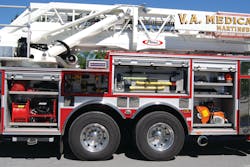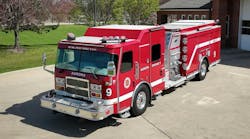You have probably heard at some point in your fire service career of a fire department that acquired a new apparatus only to be disappointed after it operated with the rig for a time and things were just not working out. Equipment did not fit into the compartments, the hosebed was too high and the cab seating arrangement was too cramped. If these are some of the symptoms of a poorly designed apparatus, who is too blame?
Unlike a leased automobile, the fire department generally cannot turn the rig back in at the end of 36 months and any mistake made during the purchasing process is going to impact the unit’s performance and ultimately the safety and effectiveness of your operations. How often have you heard a senior member of the department refer to the newest apparatus in less-than-flattering terms with an expression like, “We can’t wait to get rid of this rig”?
Let’s look at some practical guidelines to ensure that you specify the new apparatus that meets the needs of the department and your response district.
Guideline 1
Define the mission of the vehicle
If the department plans to replace an existing engine or ladder truck, the mission may be straightforward. Combination units such as rescue-engines, quints of any description and initial-attack units must be carefully thought out. How do you plan to staff, equip and operate this unit? What is its expected life cycle? What is the anticipated tool, hose and equipment weight that you are going to carry?
Have the apparatus committee members each list the five most important things this new apparatus will have to accomplish and compare these ideas. Make sure that everyone is on the same page with respect to the expectations for this vehicle at the outset.
Guideline 2
Assign qualified apparatus committee members
The preferred size of the apparatus committee should be no more than four to six personnel. These should include a chief officer, training and maintenance staff, engineers/drivers, company officers and fire-rescue personnel who will operate this vehicle. Having stakeholders who have a vested interest in the design and operation of the new vehicle will provide a range of experience and input in the specification process. Try not to get bogged down with having too many members on the formal committee, which from our experience results in the old adage “too many cooks spoil the broth.”
Guideline 3
Avoid purchasing-one-of-a-kind rigs
When you are meeting with apparatus sales personnel and your idea of what to put on your new rig is met with some quizzical looks, that is your first sign that you may be asking for something that has never been engineered and successfully built. Asking for a different location for steps or a rear body discharge is one thing. If the committee members have their minds set on a new electronic pump control system or foam system that you just heard about and the manufacturer has no experience with this component, it is time to re-think the process and get back to basics.
When you speak with fleet mechanics about vehicle down time, it is often the seldom-used system or electronic component that has deadlined the rig waiting for parts. Make sure that the various components that you want to specify on your new apparatus have a demonstrated track record and are backed up with solid warranty provisions by the company.
Guideline 4
Avoid multiple purchases at one time
Unless you have a large fleet, never buy more than one fire truck at a time. The only actual potential savings is several thousand dollars in engineering costs. What you have done by buying multiple units at one time is making replacing them in 15 to 20 even more difficult.
While the department may have had the financial resources to buy two units at one time now, the reality is that when these units wear out at the same time and require replacement, there may not be sufficient funds to have a repeat performance. Several large cities replaced entire fleets within several years, only to find out that sufficient resources were not guaranteed to fund an apparatus-replacement program, with the result that the aging fleet suffers from maintenance issues with resulting higher operating costs.
Guideline 5
Develop boilerplate requirements that favor the department
Every apparatus manufacturer has standard “Requirements for Bidders” with their specifications. While this verbiage reads well, in most cases, these boilerplate statements favor the manufacturer and not the agency signing the contract. Technical language covering bid submissions such as bid and performance bonds, electrical load and weight analysis and critical vehicle dimensions must be written clearly and encourage bidders to submit proposals while protecting the department’s financial interests.
Guideline 6
Provide an equipment inventory list
The apparatus committee and/or the fire department should give the apparatus salesperson a comprehensive and complete tool and equipment list for the new apparatus. Both parties should sign and date this list and each party should retain a copy. When you weigh your apparatus before final payment is made and it is found to be overweight, and the salesperson denies knowing prior to the build that you were going to put all that equipment on the truck, you can then get your copy of the signed tool and equipment list. It is a great way for a fire department to protect itself.
Guideline 7
Clearly define the terms for acceptance and payment
Many apparatus builders require full payment upon delivery to the fire department. While some larger communities’ purchase orders or contracts stipulate standard payment terms of net 30 days, the manufacturer’s contract will clearly define how and when payment is to be made for the completed apparatus. These terms may not favor the purchasing authority and your boilerplate requirements should specify the terms of acceptance, including having all final-inspection “punch list” items repaired and copies of all manuals and testing certifications. All tools, hose and equipment should be loaded on the apparatus as well.
The apparatus should be weighted in accordance with National Fire Protection Association (NFPA) 1911, Standard for the Inspection, Maintenance, Testing and Retirement of In-Service Automotive Fire Apparatus, Section 16.2.3, with weight tickets provided to ensure that the apparatus is not overloaded and complies with the chassis gross vehicle weight rating (GVWR) and the manufacturer’s original weight analysis. The final payment for the apparatus should not be made until the department can confirm the actual in-service weight of the vehicle. Unfortunately, many departments have not recognized that a new vehicle is overloaded until well after delivery and, in some cases, after several years of in-service use.






